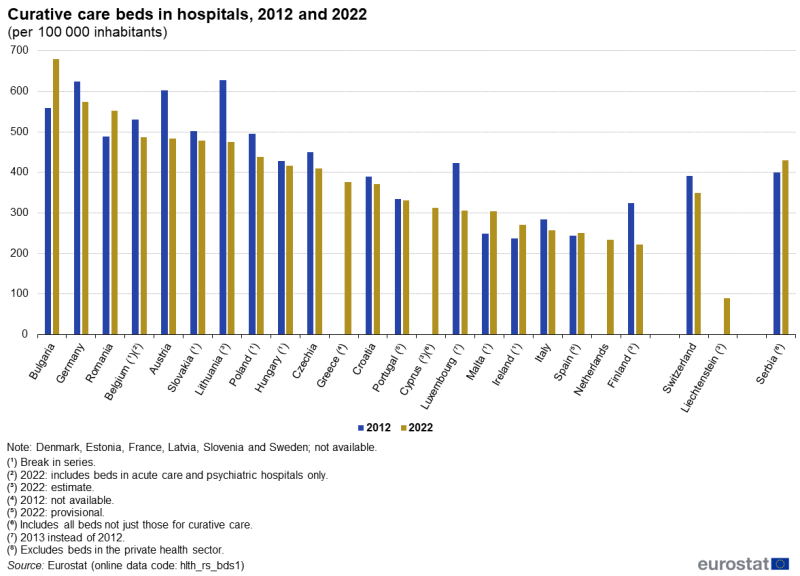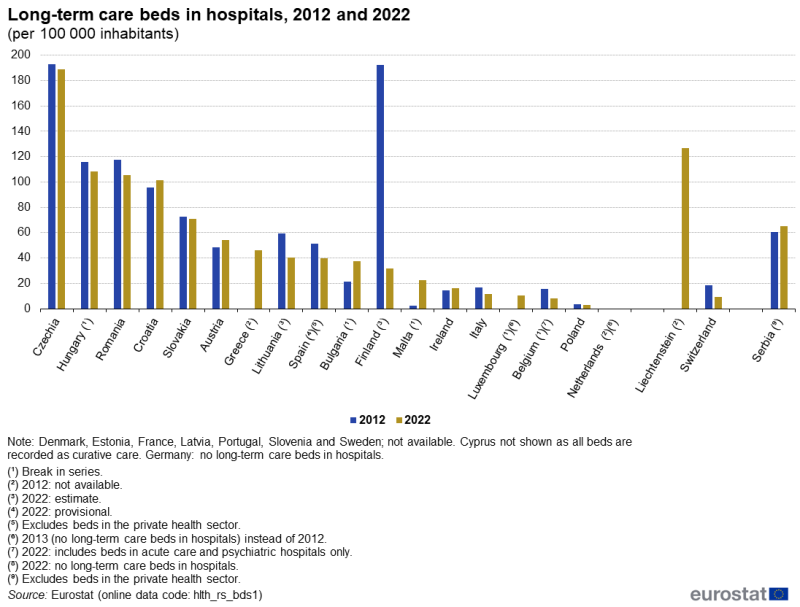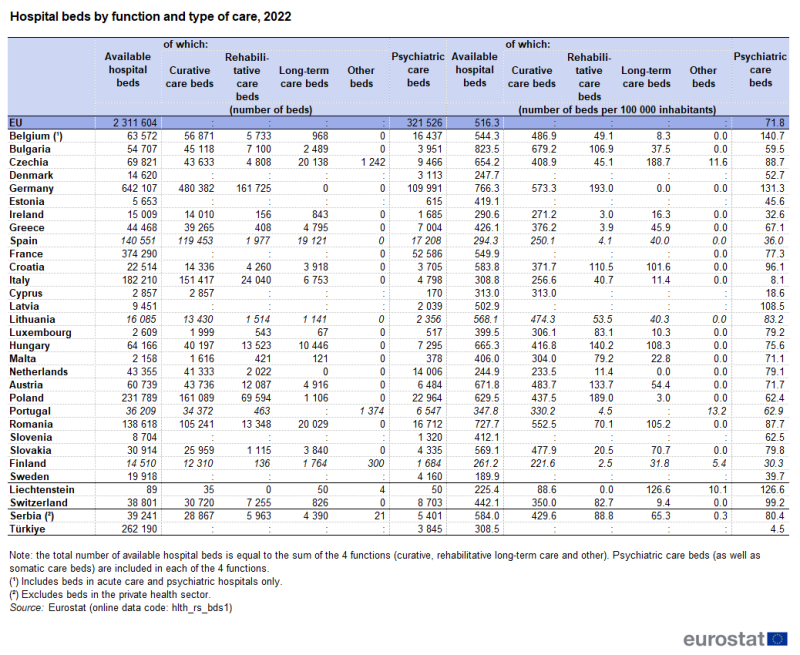Data extracted in July 2024.
Planned article update: 15 July 2025.
Highlights
Among EU countries, Bulgaria, Germany and Romania had the highest number of hospital beds relative to population size in 2022.
Most EU countries reported fewer curative care beds in hospitals per head of population in 2022 than 10 years earlier.
Most EU countries reported more rehabilitative care beds in hospitals per head of population in 2022 than 10 years earlier.
Curative care beds in hospitals, 2022
This article presents an overview of European Union (EU) statistics related to the availability of hospital beds as well as the availability of beds in nursing and other residential long-term care facilities. Hospital beds include beds for curative care, long-term care and rehabilitative care.
This article is one of a set of statistical articles concerning health status in the EU which forms part of the online publication on Health in the European Union - facts and figures.
Hospital beds
In 2022, there were 2.3 million hospital beds available for use across the EU. Around three-quarters of these were for the curative care function. Most of the remainder were beds for rehabilitative care. Recent methodological changes in the classification of hospital beds have resulted in psychiatric care beds being included – alongside somatic care – among the various functions of beds (curative, rehabilitative, long-term care and other). However, a separate subtotal for psychiatric care beds (across all 4 categories) is also available (see Table 1).
Bulgaria, Germany and Romania had the highest numbers of hospital beds relative to population size
An analysis of the number of hospital beds in relation to population reveals that there were, on average, 516 hospital beds per 100 000 inhabitants in 2022 across the whole of the EU. Among the EU countries, Germany recorded not only the highest number of hospital beds (642 000), but also the 2nd highest number relative to population size, with 766 beds per 100 000 population (see Table 1). The only EU country with a higher ratio relative to its population size was Bulgaria, with an average of 823 hospital beds per 100 000 inhabitants. Romania recorded the 3rd highest ratio, 728 hospital beds per 100 000 inhabitants. Spain, Ireland, Finland, Denmark, the Netherlands and Sweden each recorded fewer than 300 beds per 100 000 inhabitants.
The share of beds for the curative care function among all hospital beds in 2022 was highest in the Netherlands, Portugal and Ireland, at 95.3%, 94.9% and 93.3%, respectively. Elsewhere, curative care beds accounted for less than 90.0% of all hospital beds. Less than two-thirds of all hospital beds were for curative care in Croatia, Hungary and Czechia (where the lowest share was recorded, at 62.5%). Note that data on curative care beds aren’t available for 7 countries (see Table 1 for more details).
Poland recorded the highest share of beds for the rehabilitative care function which accounted for 30.0% of the total number of hospital beds in 2022, while this share was also above 15.0% in Germany, Hungary, Luxembourg, Austria, Malta and Croatia. In 7 of the 20 EU countries for which data are available, this share was below 5.0%, with the lowest shares (below 2.0%) in Spain, Portugal, Ireland, Finland and Greece.
In most of the 19 EU countries for which data are available, beds for the long-term care function accounted for less than 15.0% of the total number of hospital beds in 2022, with only Hungary (16.3%), Croatia (17.4%) and Czechia (28.8%) reporting higher shares. This share was 0.5% in Poland and there were no long-term care beds in Germany or the Netherlands.
Decreasing availability of hospital beds in most EU countries
Between 2012 and 2022, the total number of hospital beds in the EU decreased by 6.8%. In the majority of EU countries, the number of hospital beds (in absolute terms) was lower in 2022 than it had been in 2012. In relative terms, the largest contraction in the number of hospital beds was recorded in Finland, where overall bed numbers fell by 49.3% between 2012 and 2022. There were 6 EU countries where the total number of hospital beds rose between 2012 and 2022: Spain (up 0.5%), Portugal (up 1.1%), Romania (up 4.8%), Malta (up 9.2%), Bulgaria (up 13.2%) and Ireland (up 28.4%); note that there are breaks in series for Ireland and Malta.
Figures 1 to 3 provide an analysis of the changes between 2012 and 2022 in the availability (relative to the size of population) for 3 specific functions: curative, rehabilitative and long-term care. These changes in the number of hospital beds can be compared with changes in the average length of stays for in-patients and the number of hospital discharges in order to analyse developments in the supply of and the fulfilled demand for hospital beds.
Between 2012 and 2022 (see Figure 1 for information about the coverage for individual EU countries), an increase in the number of curative care beds in hospitals (relative to the population size) was recorded by 5 of the 18 EU countries for which data are available. There was a relatively small increase in Spain, while this ratio rose at a faster pace in Ireland (break in series), Malta (break in series), Romania and Bulgaria, with increases of 35, 55, 63 and 120 beds per 100 000 inhabitants respectively. During the period under consideration, 4 EU countries experienced decreases in excess of 100 beds per 100 000 inhabitants: Finland, Luxembourg (2013–22), Austria and Lithuania, down 103, 116, 119 and 154 beds per 100 000 inhabitants, respectively.

(per 100 000 inhabitants)
Source: Eurostat (hlth_rs_bds1)
Rehabilitative care beds accommodate hospital patients with the intent to stabilise, improve or restore impaired body functions and structures. During the period 2012 to 2022, the number of rehabilitative beds relative to population size increased in 10 out of 17 of the EU countries for which data are available (see Figure 2 for details of the data coverage). The number of rehabilitative care beds increased by more than 10 beds per 100 000 inhabitants in Romania, Austria, Poland (break in series) and Bulgaria: the last of these recorded the highest increase with an additional 36 beds per 100 000 inhabitants. By contrast, the number of rehabilitative care beds relative to population was unchanged in Italy and decreased in 6 EU countries between 2012 and 2022. Decreases were generally greater than 10 beds per 100 000 inhabitants in Luxembourg (down 11 beds per 100 000 inhabitants; break in series), Hungary (down 15 beds per 100 000 inhabitants; break in series) and Germany (down 17 beds per 100 000 inhabitants).

(per 100 000 inhabitants)
Source: Eurostat (hlth_rs_bds1)
Among the 16 EU countries for which data are available (see Figure 3 for details of the data coverage), 10 recorded a downward development in the number of long-term care beds per 100 000 inhabitants during the period 2012 to 2022. By far, the largest fall was recorded in Finland, dropping from 193 to 32 beds per 100 000 inhabitants between 2012 and 2022. There were 6 EU countries where there was an increase in the number of long-term care beds relative to population size. The largest increases – all up by at least 10 additional beds per 100 000 inhabitants – were in Malta, Bulgaria and Luxembourg, but all have a break in series. Note that Germany didn’t report any long-term care beds in hospitals.

(per 100 000 inhabitants)
Source: Eurostat (hlth_rs_bds1)
Beds in nursing and other residential long-term care facilities
The number of beds in nursing and other residential long-term care facilities relative to population size increased in most EU countries
While the analysis presented so far has focused on beds in hospitals, this final section looks at beds in nursing and other residential long-term care facilities. In 2022, there were approximately 3.5 million beds in these facilities across the 26 EU countries for which data are available (no data available for Portugal).
Relative to population size in 2022, the highest number of beds in nursing and other residential long-term care facilities was recorded in the Netherlands, with 1 420 per 100 000 inhabitants (see Figure 4). Sweden, Belgium and Malta recorded rates between 1 259 and 1 299 beds per 100 000 inhabitants. In most of the remaining EU countries for which data are available (no data for Portugal), the number of beds in nursing and other residential long-term care facilities exceeded 600 per 100 000 inhabitants.
Below this, Italy had 480 beds per 100 000 inhabitants. There were between 214 and 286 beds per 100 000 inhabitants in Cyprus, Latvia (coverage is broader), Croatia, Romania and Poland. The lowest numbers of beds were in Greece and Bulgaria, at 26 and 25 per 100 000 inhabitants, respectively.

(per 100 000 inhabitants)
Source: Eurostat (hlth_rs_bdltc)
A comparison of 2012 and 2022 data reveals that there was an increase in bed numbers per 100 000 inhabitants in most of the EU countries for which data are available (no data for Greece, Cyprus or Portugal). Relative to population size, the number of beds in nursing and other residential long-term care facilities fell in Denmark, Latvia, Sweden, Bulgaria, the Netherlands and Ireland although all of these EU countries reported a break in series. The largest increase was in Luxembourg, followed by Malta, Estonia, Lithuania and Slovenia, all of which except for Lithuania also had a break in series. Among the EU countries without a break in series, the largest increase was in Lithuania (up 148 beds 100 000 inhabitants) and the smallest increase was in Finland (up 18 beds 100 000 inhabitants).
Source data for tables and graphs
Key concepts
Data sources
Hospitals comprise licensed establishments primarily engaged in providing medical, diagnostic and treatment services that include physician, nursing and other health services to in-patients, and the specialised accommodation services required by in-patients. Hospitals may also provide out-patient services as a secondary activity. Speciality hospitals, including mental health and substance abuse hospitals, are also covered.
Long-term care institutions refer to nursing and other residential care facilities which provide accommodation and long-term care as a package. Beds in nursing and other residential long-term care facilities are recorded separately from hospital beds.
Hospital beds are those beds which are regularly maintained and staffed and immediately available for the care of admitted patients. Occupied and unoccupied beds are both included. Excluded are recovery trolleys and beds for same day care (day care and out-patient care), provisional and temporary beds. Hospital beds can be partitioned by function and by category/type of care.
Total hospital beds by function = curative (acute) care beds + rehabilitative care beds + long-term care beds + other hospital beds
- Curative care beds in hospitals are for patients where the principal clinical intent is to do 1 or more of the following: manage labour (obstetric), perform surgery, cure or treat (including relieving symptoms, reducing severity, or protecting against exacerbation and/or complication) non-mental illness or injury, perform diagnostic or therapeutic procedures. They include beds for psychiatric and non-psychiatric curative (acute) care, from general hospitals, mental health hospitals and other specialised hospitals. Beds for palliative and long-term nursing care are recorded under long-term care.
- Rehabilitative care beds in hospitals are beds accommodating patients with the principal intent to stabilise, improve or restore impaired body functions and structures, compensate for the absence or loss of body functions and structures, improve activities and participation and prevent impairments, medical complications and risks. They include beds for psychiatric and non-psychiatric curative (acute) care, from general hospitals, mental health hospitals and other specialised hospitals.
- Long-term care beds in hospitals are for patients requiring long-term care due to chronic impairments and a reduced degree of independence in activities of daily living, including palliative care. They include beds for psychiatric and non-psychiatric long-term care, from general hospitals, mental health hospitals and other specialised hospitals.
- Other beds include all other beds in hospitals not elsewhere classified.
Total hospital beds by category/type of care = somatic care beds + psychiatric care beds
- somatic care means healthcare relating to the body, as distinguished from psychiatric care
- psychiatric care means healthcare concerning the mind, for example, dealing with mental and behavioural disorders. Psychiatric care beds include all beds in mental health and substance abuse hospitals, as well as beds in psychiatric departments of general and specialty hospitals
Statistics on healthcare resources (such as beds in hospitals as well as nursing and other residential long-term care facilities) are documented in this background article which provides information on the scope of the data, its legal basis, the methodology employed, as well as related concepts and definitions.
For country specific notes on the collection of healthcare non-expenditure statistics, please refer to the annexes at the end of the national metadata reports accessible from links at the beginning of the European metadata report.
Tables in this article use the following notation:
| Value in italics | estimate or provisional data; |
| Value is : | not available. |
Context
Indicators concerning the number of hospital beds (and their function and category/type of care) complement information on healthcare expenditure, hospital personnel and equipment to provide an overview of the resources available for delivering healthcare in hospitals. It should be noted that the information on hospital beds only covers beds for in-patient care: many hospitals also provide day care and out-patient care and beds used for these services are excluded from the information presented.
In many areas, technological developments have reduced the average length of stay for in-patient procedures or replaced procedures requiring in-patient care with ones that can be provided to day care or out-patients. As such, it is commonplace to find the total number of available hospital beds falling over time in many of the EU countries.
Explore further
Other articles
Online publications
Healthcare resources
- Physicians
- Nursing and caring professionals
- Dentists, pharmacists and physiotherapists
- Medical technology
Methodology
General health statistics articles
Database
- Health (hlth)
- Health care (hlth_care)
- Health care resources (hlth_res)
- Health care facilities (hlth_facil)
- Available beds in hospitals by NUTS 2 region (hlth_rs_bdsrg2)
- Beds in nursing and other residential long-term care facilities (hlth_rs_bdltc)
- Hospital beds by function and type of care (hlth_rs_bds1)
- Health care facilities (hlth_facil)
- Health care resources (hlth_res)
Thematic section
Selected datasets
- Health (t_hlth)
- Health care (t_hlth_care)
- Hospital beds (tps00046)
- Available beds in hospitals by NUTS 2 regions (tgs00064)
- Health care (t_hlth_care)
Methodology
Manuals and guidelines
Metadata
- Healthcare non-expenditure statistics (ESMS metadata file – hlth_res_esms)

